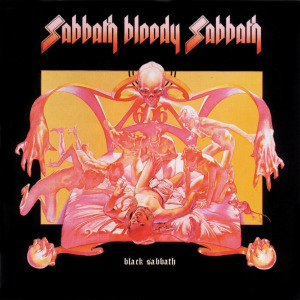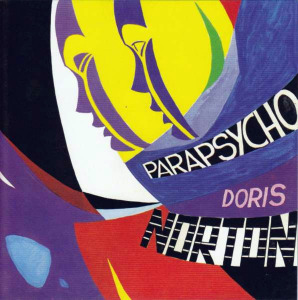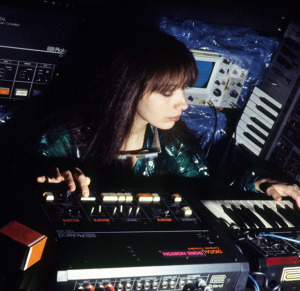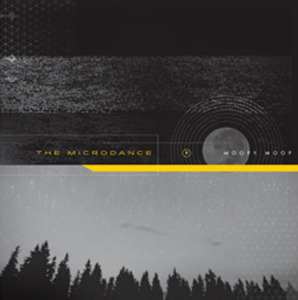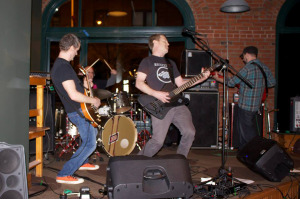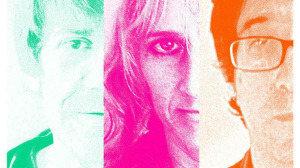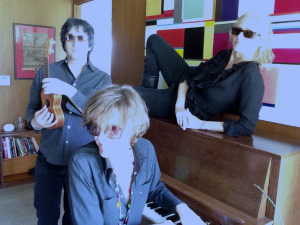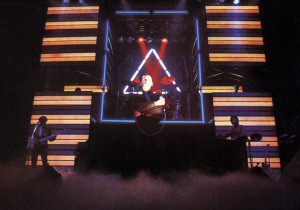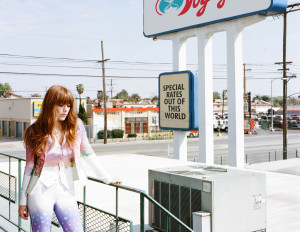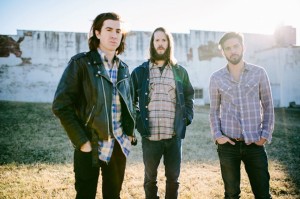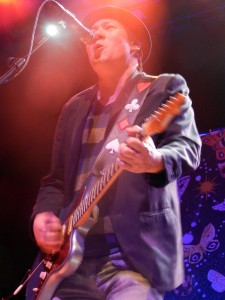(Ruminations of a music junkie, by KEVIN RENICK)
It’s interesting how certain albums come to mean so much to you, the longer you are an active music fan. From 1976 to 1979, I worked at a major record store, which increased my access to all kinds of new and upcoming artists. I also began to read music magazines obsessively, so I was able to follow the music scene really attentively. Hundreds and hundreds of albums crossed my path during that time and beyond. I went to college from 1980 to 1983, and that, too, brought a ton of new artists into my life. So-called “new wave” music ruled at that time, with artists such as Elvis Costello, the English Beat, the Clash, the Cars and many more finding favor among people I hung out with, and my friend Tina Carl and I began trading and sharing and even dancing to a lot of the music at that time. There was so much stuff I loved, but the sheer volume of it probably prevented most of it from becoming INFLUENTIAL. And that is my focus here: what were the albums that actively, in a meaningful way, became an influence on my life and creative journey? So, here is part two of that list of 25, carrying us from the late 70s to the present…
14. TALKING HEADS: FEAR OF MUSIC and REMAIN IN LIGHT (tie)
This is the second time I am cheating by calling a TIE between two albums. I pretty much HAVE to, because each of these albums by the New York new wave group fronted by David Byrne was HUGE for me. FEAR OF MUSIC came out while I worked at Record Bar, in the summer. It was an amazing piece of work, quirky as hell, rhythmically unique and heavily atmospheric. Songs like “Air,” “Cities,” “Animals,” “Drugs” and the new wave dance anthem “Life During Wartime” were like catnip for my ever-growing interest in offbeat music. And the hypnotic piece “Mind” became the unofficial breakup song for me and that girl who looked like Joni Mitchell. I loved this band, and the fact they were produced by my new hero, Brian Eno, was a bonus. But the following year, while I was attending Webster University, the incomparable REMAIN IN LIGHT came out. Influenced by African high life music, and featuring Eno again as producer and even co-writer of many of the tracks, this was just a full-on masterpiece of innovative modern rock. I absolutely went gaga over it, and “Once In A Lifetime” remains, to this day, one of the most instantly captivating weird songs ever recorded. Topping things off, MTV was becoming a going concern, showcasing this new “music video” art form to a fast-growing, interested public, and the Heads’ video for this song got huge attention. My friend Ted Moniak and I also discussed this album at length in college, and I remember him taking a long verse from the song “Crosseyed and Painless”, and writing the lyrics on a piece of paper which he posted on a door in the theatre conservatory to make a point. These were major, heady days of music listening for me, always intense, always communal. REMAIN IN LIGHT is truly one of the greatest and most interesting albums of all time, and that coincided with it being influential for me in its awesome creativity, its often dark and globally inclusive mood, and a palpable sense of ALL things truly being possible now. It made me want to learn about ethnic music, and my mind just kept opening more and more…
15. NICK DRAKE: FIVE LEAVES LEFT

I didn’t know anything about Nick Drake when he was alive and making music (1969-1974). It was some years later that I learned about him through my friend, Ted. The doomed British singer/songwriter, who died at the age of 24 either through suicide or an accidental drug overdose (theories differ on that), was an instantly compelling new “find” for me. Nick always sounded like he was apart from the rest of humanity, a lonesome figure who couldn’t fit in and related more to nature and quiet moments than anything else. I probably identified a little too much with this, I have to say. FIVE LEAVES LEFT was his first album, and it’s one of the best debut albums ever. I love every song on it; “Time Has Told Me,” the gorgeous “River Man,” “Cello Song” and “Fruit Tree” are just a few of the timeless, intimate songs on this album. I began performing “River Man” as a musician myself some years later; the mood of isolation combined with a deep reverence and connection to nature, was a recurring and potent theme in Nick’s music. Also, the way his career never took off (fame eluded him during his lifetime; it took a clever Volkswagen commercial using his song “Pink Moon” to catapult him to real fame after his death) and the aching solitude made me start thinking much more about the uncertainties of being an artist and the pain of being perhaps too sensitive. This is essential singer/songwriter stuff, and will likely always be one of my top 10 albums of all time.
16. BRIAN ENO: ON LAND
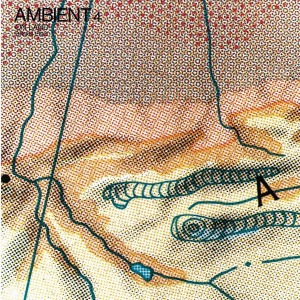
I already covered Eno’s album DISCREET MUSIC, which found him inventing a new kind of music that baffled many listeners and critics at the time. And in 1979, he basically announced ambient music as an “official” new genre with the release of MUSIC FOR AIRPORTS, labeled as “Ambient 1” in his new series at the time. That album was influential, for sure, but 1982’s ON LAND was so far ahead of the game in this genre, so much farther than his own DISCREET MUSIC, in fact, that in a way, my life instantly changed right then and there. If DISCREET MUSIC had made me feel like dreams had come to life, ON LAND recreated the experience of being lost in nature, and thinking about the most private and long-gone of memories while doing so. It was a series of rather lengthy pieces with titles such as “Lizard Point,” “The Lost Day,” “Lantern Marsh” and “Unfamiliar Wind,” all of which were made in such a mysterious process that almost no recognizable instruments appeared on them. Eno had traveled deeply into new, mysterious musical territory, and in these heady days before the internet, finding albums like this and maybe, just MAYBE encountering another human being who liked it, made you part of a cult in a way. I was utterly, utterly shocked and amazed that an album like ON LAND, which vividly captured the way I felt when I was out in nature, watching birds and feeling the glorious solitude of my surroundings, could exist. I had literally never been so affected by an album before, and I went a little nuts. I started collecting every article and review of Eno I could find, even compiling a scrapbook. More significantly, I decided I had to write to Brian Eno himself and express my admiration. It was a crazy, bold impulse, but I was unstoppable; I wrote about a 25-page letter to Mister Eno telling him about how I had long dreamed of a kind of cinematic, pastoral music that would evoke landscapes and the mysteries of life, and how in awe I was that HE had single-handedly created this music. Late in 1982, one day when I was at Webster University, I was flabbergasted when Eno answered my letter. He was warmly appreciative of my enthusiasm, hand-wrote a 3-page letter to me, and shared some of his thoughts about this bold new music that was happening. We corresponded several times, and it was a highlight of my life. It’s possible that ON LAND is, in fact, the MOST influential album of my life, it depends on how you want to measure these things. But the way this album combined many of my interests, veered sharply into unknown and haunting new sonic territory and carried with it an entire new philosophy about recorded musical art, was to change the big picture for me forever. And the time I played it on my car stereo at sunrise while driving into the Grand Canyon National Park, is one of the most unforgettable listening experiences of my entire life.
17. COCTEAU TWINS: VICTORIALAND

Ah, the Cocteau Twins. Their fans sigh and swoon at the mere mention of this so-called “shoegaze” band (a lousy label that some critic made famous, even though none of the dreamy sounding bands saddled with that label could stand it). You’re lucky in life if you meet friends who introduce you to some new band that goes on to really affect you, a band you might not have encountered otherwise. That was the case with my first introduction to this ethereal Scottish trio. Liz Fraser, the sublimely gifted female singer who fronted the band, sang like no one else EVER, not even singing understandable lyrics until the last years of the band. Instead, fans were treated to wailing, intoning, swooping and soaring, shiver-inducing tones and unearthly vocal bursts that were uncategorizable. With her partner at the time, Robin Guthrie, who conjured one of the most recognizable and groundbreaking painterly guitar sounds to ever come along, the Cocteau Twins (joined by bassist Simon Raymonde on most of their albums) earned in instant cult following with their visionary sonic palette. Many of their albums are now considered classics, but VICTORIALAND, a largely acoustic and sparsely played recording, has some of their most singularly beautiful moments. It’s music that is not easy to describe. In many ways, it is ambient, because Liz Fraser does not sing understandable lyrics, and the overall mood, a haunted one, is what you respond to most. The music is wintery, solemn and desolately beautiful, filled with mystery and destinations unknown. Some friends and I listened to it one day while we were all sprawled out on the floor together at a party, in a totally receptive mood. There was a sense of discovery at this time in the mid 80s that was magical, and by the time the internet came along and music like this was analyzed and discussed to death by countless pundits, some of that mystery went away. But the Cocteaus’ powerful music endures (though they disbanded in the late 90s), and Robin Guthrie is now a prominent ambient musician and soundtrack composer, continuing the awesome legacy of this pioneering band.
How it influenced me: By proving that truly wondrous music could render lyrics irrelevant, by emphasizing mystery over almost everything else, by demonstrating that a female voice could power a kind of “new form of ambient,” and by partially inspiring me to start writing my first novel, a story about a girl who worshipped this band, and happens to get embroiled in a supernatural murder mystery. Not sure if the novel will get finished or not, but if it does, I am contacting Robin Guthrie to compose the score.
18. REM: AUTOMATIC FOR THE PEOPLE
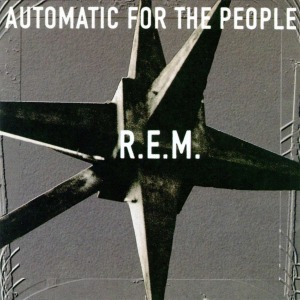
This Athens, Georgia band became heroic in the ’90s for their status as one of the ultimate college bands and for helping to create the very notion of what “indie rock” meant. Michael Stipe had a unique, stylish approach to vocals (in the early days he utilized a kind of beguiling mumble), and there was something about the SOUND of these guys that was able to keep growing an audience year after year. “Losing My Religion” became their most classic song, but in 1992, they released AUTOMATIC FOR THE PEOPLE, an evocative song cycle about loss, change and disillusionment. Three of my favorite themes! This was an autumnal album, one that I played constantly and featured regularly on road trips with a couple of friends. It was conceptually solid, deeply moving and strangely comforting. I reacted most to the melancholy songs like “Try Not to Breathe” (a painful song about an old person’s last moments), “Sweetness Follows” (heartbreaking song, with potent cello playing, about the aftermath of a death in a family) “Nightswimming” and a personal favorite, “Find the River.” This album made me cry a few times, and I have to mention in particular that the song “Sweetness Follows,” a truly haunting piece, was something I listened to on the fateful day I found out that a close friend, and the founder of a publication I had written for, was killed in a horrible car accident coming home from Chicago. I was on the highway the same day, maybe an hour behind her, and didn’t find out ’til the next day what happened. It was a huge, tragic event. There were many upbeat REM songs, and I had fun growing with them album after album for almost 30 years. But it was their softer, more intimate songs that ultimately affected me the most. I don’t play this album that often because it brings back some painful memories, but it definitely had an impact.
19. PETE NAMLOOK: AIR 2
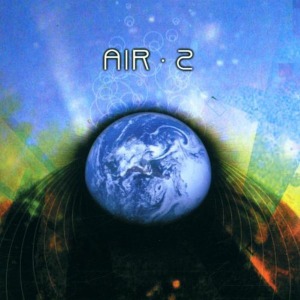
Considering that most non-aficionados consider “ambient” to be nothing more than background music, something probably with repetitive droning or tinkly keyboards and not much variety, it’s a huge surprise to discover that there’s actually a HUGE diversity of sounds and approaches in the world of ambient releases. That topic will be discussed in depth another time on this site, but I have to include a Pete Namlook album on my list because Pete, like Eno, created an entire world of ambient releases. He launched a private German record label called Fax in the early 90s, and began releasing limited-edition recordings that became collectors items fairly quickly. The releases spanned the musical spectrum from straight ambient to stuff heavy on beats to weird experimental things to jazz stylings and beyond. Fax fans were challenged by all this and discussed Pete’s work on several key websites. One of the best pairs of ambient recordings on Fax was the first two volumes in a series called AIR. These were meant to be expansive, “ethno-ambient” projects that included instrumentation far beyond mere drones and keyboards. AIR 2, in particular, was a spectacular album. It’s hard to even describe, because it constantly changes, from hypnotic travelogue soundscape (with subtle rhythms) to breezy synth to chanted middle-eastern sounding vocals to glassy, wind chimey stuff and more. “Traveling Without Moving” is the subtitle of the work overall, but it is so filled with diversity, and so enthralling to listen to while driving, that it became a personal landmark for me. I played the entire thing in my car while driving in the mountains of Colorado one evening, with some dangerous conditions happening, and it was one of the most amazing cinematic experiences of my life. This is real musical art, raising the notion of “ambient to a much, much higher level.”
How it influenced me: By creating a bold, fascinating new vision of what ambient could be, and by allowing me to lure friends and other newbies into the ambient “fold” by providing a stellar, immersive and unforgettable listening experience.
20. RADIOHEAD: OK COMPUTER
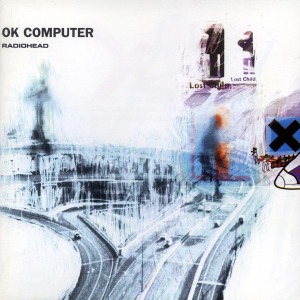
Radiohead took the music world by storm with this album. It seemed to come out of nowhere, and it was said to be an epic meditation on millennial angst and the growing encroachment of technology in our lives (with the subsequent alienation we were sure to face). I was utterly enthralled with this recording; it really did achieve some sort of pinnacle of creativity for a rock album. Having always loved high, emotive male voices, Thom Yorke’s singing on stunning tracks like “Paranoid Android,” “Subterranean Homesick Alien,” “Let Down,” and “Lucky” was spine-tingling, and the arrangements (and production by Nigel Goodrich) maximized the emotional impact. I listened to this one over and over; it was a thoroughly modern rock masterpiece that took me back to the days of listening to Pink Floyd, Yes and the Moody Blues when I was a teen. The underlying anxiety about the future and the ups and downs that were soon to come with the pervasiveness of the internet and other technologies, were deeply ingrained in the musical aesthetic of this record.
How it influenced me: By announcing a new candidate for “Best group in the world,” showcasing powerful new songwriting and arrangements in a neo-prog rock idiom, and reminding me clearly of the power of writing music that echoed the times and tried to make people think and feel about our fate as humans.
21. THE DOMINO KINGS: LIFE AND 20
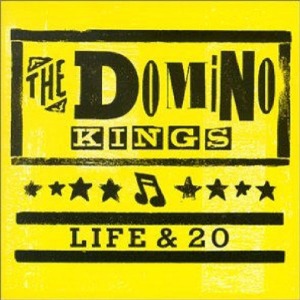
This is the only Missouri album on my list, and at this writing, it is out of print, sadly. The trio of guitarist Steve Newman, upright bassist Brian Capps and drummer Les Gallier, based in Springfield, play roots music that blends barroom country and early rock and roll into a snappy, lively formula that is a genuine pleasure to listen to. But that’s not why the album is on my list. It’s here because the album came out when I was an active music journalist for a publication called NOISYPAPER, and I was assigned to review a show by the Domino Kings. I met Brian Capps and struck up a friendship with him. Just a few years later, when I saw Brian in concert again, I was about to endure one of the most painful relationship breakups of my entire life, and Brian’s songs not only served as a bit of a soundtrack for this period, they made me want to dance through the heartache. The Kings were (and still ARE) crack musicians, capable of playing the kind of alcohol-fueled, lost-at-love rave-ups that patrons have been dancing to and enjoying for years. On this album, the Capps tunes “Borrow A Lie,” “Alice” (a wickedly catchy stomper about a bad, bad woman), “Don’t Be Indifferent” and “Steppin’ Out Again” all deal with the kind of women and relationships that tear a man’s soul apart. As this happened to me at the end of 2003 and the first part of 2004, I got to hear Brian Capps perform live several times, with most of these tunes in the mix. And he was kind enough to discuss relationships with me and tell me his own stories of romantic woe. Very cathartic and significant. Additionally, the Kings’ music increased my awareness that Springfield, Missouri was a center of musical vitality. Not far in my future at this point was a deep connection and involvement in that city that would affect my own music career dramatically.
22. EPHEMERA: BALLOONS AND CHAMPAGNE

It’s funny how one little action can end up leading to something much bigger, something you couldn’t predict. By 2002, I was working at an advertising agency, getting into the groove of internet communication and browsing, and trying to learn about new music and discover new things. I had read a few things about Norwegian music, just sort of casually, and I ended up purchasing a CD called THIS IS NORWAY on impulse. It was a compilation of Norwegian pop and rock bands, and there was a track by a band called Ephemera on there. I had never heard of them, and knew nothing about them. The song, “Last Thing,” featured several female singers offering beautiful, tight vocal harmonies, and unusually crystalline keyboards and production. It stood out, and I wanted to know more about this group. Nothing by them was available in the US, but I ordered this album, BALLOONS AND CHAMPAGNE. Lordy. It so far exceeded anything I could have expected, that it’s hard to put into words. It was like realizing your eyes have been impaired for a long time, causing you to never see certain details, and then being given a pair of stunning new glasses that brighten up the entire world, with colors, details and landscapes you were never aware of appearing vividly before you. The three women of Ephemera – Christine Sandtorv, Ingerlise Storksen and Jannicke Larsen – are singer/songwriters of peerless, diamond-pure talent. Since I have an interview with Ingerlise pending, I’ll save most of my thoughts for that piece. But I was bowled over by this magical trio from the start, and they are one of my absolute favorite musical groups in the world. On BALLOONS AND CHAMPAGNE, tracks such as “Act,” “Air,” “Bye” and the title track are such heartbreakingly beautiful, with emotive, delicate singing and a level of purity that I had almost never heard on an American record. I love literally every song this band has recorded, and I came to the conclusion early on that they don’t really know how good they are. They are some kind of magical musical goddesses that simply do what they do, and trust that some people will like it. Ephemera opened up a new world to me, the world of Scandinavian pop music, which I would, within a year, be writing about regularly for a couple of different publications. They actually changed the way I LISTEN to music, because after absorbing the beauty of their vocals and the genius production techinques of their producer, Yngve Saetre, I could no longer respond the same way to typical American pop records. Here’s how passionately in love I am with Ephemera’s music. If there was a fire or a coming tornado, and I could only save a limited number of CDs from my collection, I’d grab an armful of ambient CDs and then use my other hand to grab my small stack of Ephemera CDs. They have been a HUGE, huge influence, and when I became a musician, I kept their intimate vocals in mind at all times as I advanced in my own career.
23. DANIELSON FAMILE: TELL ANOTHER JOKE AT THE OL’ CHOPPIN’ BLOCK
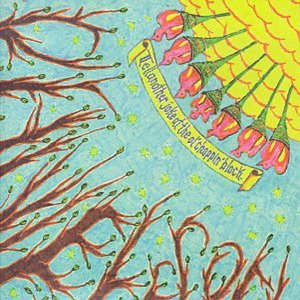
I never, never found so-called “Christian groups” musically interesting; the vast majority of what I heard in that vein seemed like the most shallow, over-reverent, musically insipid crap I could imagine. Nothing against Christianity, only something against boring music. But Lord God almighty! The Danielsons changed that in a big way. It is, of course, not cool or even accurate to call them a “Christian” band. In fact, they are so weird and arty that their first label, a Christian one called Tooth and Nail, dropped them after one album. Instead, Daniel Smith, the composer and frontman for this band along with a rotating cast of family members and friends, began to attract a following from the fringes of indie rock and outsider music. Smith has a very, very high voice, and he makes it even higher by singing one of the highest falsettos in the history of pop music. It is showcased on several tracks on this amazing, visionary album. But the entire album is notable for the focused PASSION on display, the extremely original songwriting, and the sense of communal empathy that pours from the whole thing. Less important than the Christianity of the band is their deep, poignant humanity and concern for the well-being of everyone, meaning every single listener. They really don’t PREACH per se, they simply share their souls, and they do it with powerful music that ranges from Beatles to Beefheart in influence. I’ve tried to share Danielson music with various friends, and it is honestly too much for a lot of them. When Smith ascends to that remarkable falsetto and starts ranting about something in the modern world, it results in a singular, aggressively original sound that is not meant for all. But the humanity and intensity of this album is undeniably hypnotic, emotional and yes, quite beautiful. Some of their later albums, although I like all of them, are at times spotty. But TELL ANOTHER JOKE… is a masterpiece to me.
How it influenced me: By demonstrating that religious themes on an album can be musically riveting, that the subject of confessed vulnerability (one of my favorites) is worth examining, and that weirdness and focused passion are absolutely compatible bedfellows, something I have kept in mind ever since.
24. LISA GERMANO: LULLABYE FOR LIQUID PIG

I decided to include this one among some of the final “candidates” for this list because it was a crystal-clear example of a dark, depressing album being cathartic at a time when I was lost. The very offbeat, non-commercial style of Ms Germano is an acquired taste, but fans of originality and darker artsy/folksy stuff can find a lot to love in her work. LULLABYE… was released to little fanfare late in 2003, right as I was breaking up with a girl named Star in an unexpected manner. I went into a downward spiral for a time, and this record is about just that, a downward spiral. Although I’d found other dark, sad albums in the past to be compelling, such as stuff by Neil Young, Lou Reed, Joy Division and others, Lisa Germano really let her worst fears and sorrows hang out, and the album was willfully uncommercial. Yet it had a lot of fragile beauty on it. There were some verses, and eerie sounds (inspired by struggles with alcoholism, reportedly) on this album that could absolutely get under your skin. One verse that almost brought me to tears, was “Without you here/Without your love/The world’s just THERE/It doesn’t move me.” The songs are generally short, and Ms Germano really sounds like she is fighting off a breakdown, which oughta sound familiar to anyone who has suddenly lost their love, or found themselves on the wrong end of a battle with substance abuse. This is not a fun album, but I’ll never forget how it provided therapy and catharsis during a pretty rotten four month stretch for me.
25. In order for this list to have a sense of “completeness” for me, I have to put FILM SOUNDTRACKS
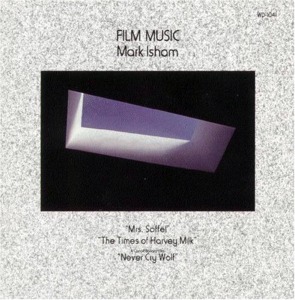
for the final slot. I don’t mean loose collections of songs, I mean orchestral scores. I grew up with film music and I love it, and my brother is one of the most knowledgeable film soundtrack buffs in the country; he writes a column about it. Film music has been described as the “first cousin” of ambient music; it’s generally instrumental, generally evocative and mood-setting, and able to be created in many different musical idioms. Watching movies and TV shows all my life, I have to say that I always noticed the music, and the mood-enhancing nature of movie music got deeply into my psyche. When I write songs now, there is always part of me that hopes to capture something subtly cinematic. There are tons of soundtracks in my collection, but to round out this list of influences, I will pick three different ones: TO KILL A MOCKINGBIRD, the beautiful Elmer Bernstein score for the classic Gregory Peck movie (with a main theme that everyone loves and remembers); DANCES WITH WOLVES, a rapturous, Western-themed score by John Barry that covers as much terrain as the epic film itself does, and NEVER CRY WOLF, by the prolific Mark Isham, whose 1983 score was one of the first ambient soundtracks ever. Isham stated in interviews that he was influenced by Brian Eno, so… it figures I could identify with his movie work!
TEN OTHER INFLUENTIAL RECORDINGS THAT MISSED OUT ON THE MAIN LIST:
NEIL YOUNG: ZUMA… THE WHO: TOMMY… MIKE OLDFIELD: OMMADAWN… XTC: ENGLISH SETTLEMENT… THE SAMPLES: NO ROOM… THE RESIDENTS: NOT AVAILABLE… PHILIP GLASS: GLASSWORKS… HAROLD BUDD AND BRIAN ENO: THE PLATEAUX OF MIRROR… MUM: FINALLY WE ARE NO ONE… PINK FLOYD: DARK SIDE OF THE MOON
SPECIAL HONORABLE MENTION:
ROBYNN RAGLAND: MODERN AMERICAN FEMALE GUT
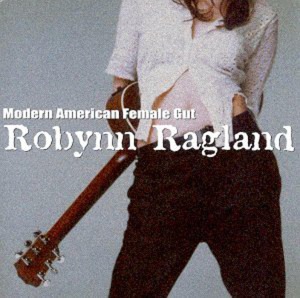
Although it didn’t feel right to place this on the main list of 25, I need to include Robynn Ragland’s record because, first of all, it was one of the most well-written and well-produced collections of songs by a local artist during my early years as a writer, first for NOISYPAPER, and then for PLAYBACK STL and fLUSH. Appreciating artists in Saint Louis wasn’t always easy, but Robynn made it a cinch. Her true significance for me was that we became close friends, and she really encouraged me with my own writing and creative pursuits. And in a twist that neither of us could have foreseen, when I had my surprising success with the UP IN THE AIR song, Robynn became my manager for a few years. She was singularly responsible for my spectacular trip to Japan to promote the movie, and I could hardly forget something like that!










